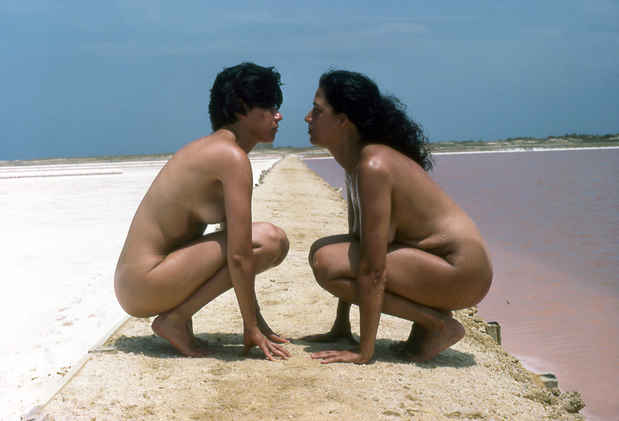Yeni & Nan "Body: Air, Water and Earth. Performances from the 70s and 80s."
Henrique Faria Fine Art

This event has ended.
The exhibition Body: Air, Water and Earth presents a selection of images from some of the actions carried out by Jennifer Hackshaw and María Luisa González between 1977 and 1984. Photographs, Polaroid images and videos make up this unique body of work, which contributed emblematic images to the history of action-based art in Venezuela.
Yeni and Nan arrived at the concept of body-art via metaphor as seen in the underwater gestures which provide us with an image and memory of the natural cycles of the origin of life. Their slow movements evoke the vastness of the oceans that were the source of life and the almost amniotic concentration inside the plastic containers that expands their movements until they emerge into the light.
It is also via metaphor that they allude to the fragility of humankind and the planet, suggesting drought, barrenness or exhaustion through the damp layer of earth that covers their faces, which gradually and dramatically dries out. However, these are not only metaphors; they are also metonyms: minutes that suggest decades or centuries; fragments of skin that evoke territories or deserts.
While in Integraciones en agua (Integrations in Water), Transfiguraciones elemento tierra (Earth Element Transfigurations), Autológica: Agua + Aire (Autologic: Water + Air) or in Nacimiento (Birth) the artists linked their bodies to more abstract natural cycles that were not situated in any particular place or time (being, instead, at once archaic and futuristic), whereas in Simbolismo de la cristalización - Araya (Crystalization Symbolism - Araya) they focus firmly on Venezuela’s geography. But this wasn’t just any Venezuelan landscape. Even after Margot Benacerraf’s camera passed through the area, Araya remained unknown enduring in silence as a powerful source of imagery. Through the symbolic and poetic power they bore within them, Yeni and Nan forged a connection to this luminous part of the world. They turned salt crystals into geometric figures that were open to the passing air and were characterized by a slowness in the gestures that created them; they immersed metal tubs in the salt so that they would crystallize over time. Their simultaneously abstract and naturalist concept and body-focused processes gave the idea, the concept a material form and produced a highly sensorial body of work that was at once tactile and visual.
In the seventies and the eighties, the duo worked in Venezuela along with a group of other performance artists working on issues such as the rituals of national identity, communication, passion and violence. It is worth pointing out that both Yeni and Nan and Antonieta Sosa –the only women in the group that was so important at that moment– emphasized intimate processes and psychophysical changes affecting the body. In contrast to the majority of Latin American artists who tend to deal with social and political issues, the work by these three artists - and Colombian María Teresa Hincapié who began working some years afterwards - was both highly self-engaged and meditative, very slowly recreating their bodies’ inner and outer rhythms. These artists had backgrounds in martial arts, psychology and theater. Their actions generated memorable experiences leaving their viewers in an almost hypnotic state.
One of the most noteworthy contributions made by Yeni and Nan is their intense yet subtle intertwining of self-reflexive and intimate links to the Twentieth-century avant-garde’s concern with ecological issues and archaic symbols from the natural world. They produced moving conceptual and aesthetic works based on humanity-as-nature: one’s body as a body of the world (and the wellbeing or tragedy of the world as one’s own wellbeing or tragedy).
This abridged yet essential show is a propitious endeavor by Henrique Faria Fine Art and seeks to initiate a revision of Yeni and Nan’s work. Given that concept and action-driven art are currently the source of broad-ranging interest on an international level, it is becoming evident that the medium is highly relevant. It is thus the perfect moment to explore the specific contributions that Latin American artists have made to the contemporary history of art.
María Elena Ramos
Jennifer Hackshaw y María Luisa González (Caracas, 1948 y 1956) first met at the Cristóbal Rojas art school in Caracas during the 1970s. In 1977, they started to work together as Yeni & Nan; moved to London, England in order to study art, and later moved to Cannes, France to study photography. The pair returned to Caracas in 1979 to study film. Yeni and Nan worked together from 1977 to 1986, the year they decided to separate in order to pursue individual art careers. While working together, they participated in numerous celebrated exhibitions, some of which include “20 Contemporary Venezuelan Artists” at the CAYC Buenos Aires, Argentina (1979); the Salon Arturo Michelena in Valencia, Venezuela (1979); various performances at the National Art Gallery of Caracas (1979, 1980, 1982, 1983); the Sao Paulo Biennial (1981); “Colloquium on Non-objective Art” at the Museum of Modern Art, Medellín, Venezuela (1981); and the “Biennial of Young Artists of Paris” at the Museum of Modern Art, Paris, France (1982). At the third National Salon of Young Artists in 1985, the duo won first prize. Yeni. Hackshaw now lives and works in Salamanca, Spain, while Nan González has remained in Caracas, where she resides and works. Each artist has continued to develop her own artistic and creative practice.
[Image: Yeni y Nan "Simbolismo de la cristalización - Araya" (1984/2013) C-Print from Ektachrome slides, 33.5 x 49.5 cm.]
Media
Schedule
from March 29, 2013 to May 04, 2013
Opening Reception on 2013-03-29 from 18:00 to 21:00